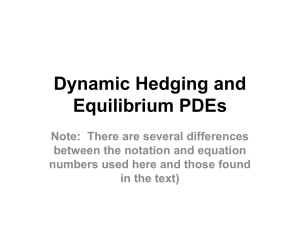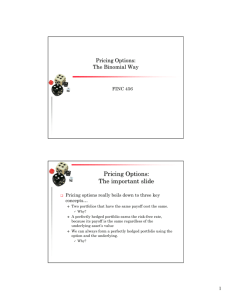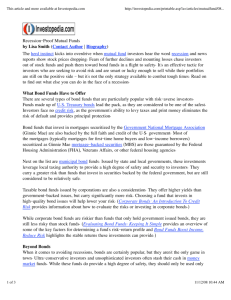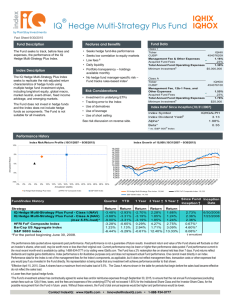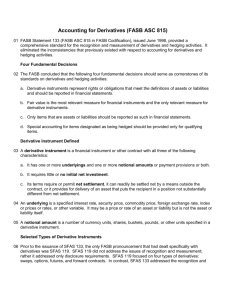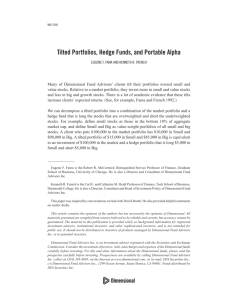RPRD 801 Exercise Sheet 2 2015
advertisement
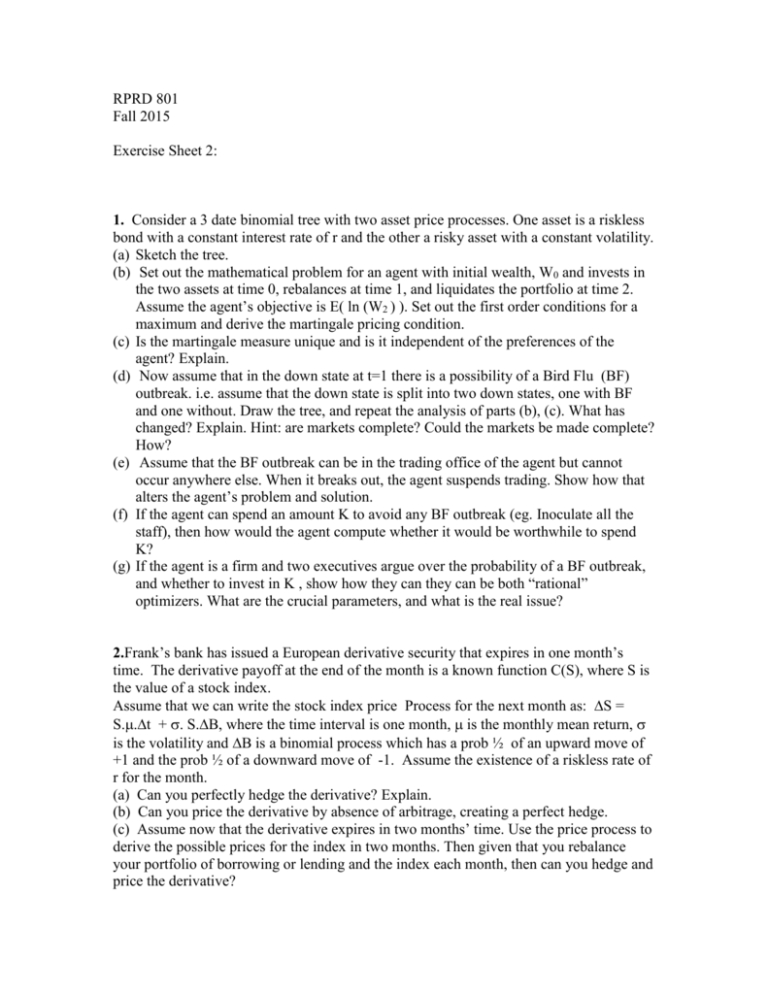
RPRD 801 Fall 2015 Exercise Sheet 2: 1. Consider a 3 date binomial tree with two asset price processes. One asset is a riskless bond with a constant interest rate of r and the other a risky asset with a constant volatility. (a) Sketch the tree. (b) Set out the mathematical problem for an agent with initial wealth, W0 and invests in the two assets at time 0, rebalances at time 1, and liquidates the portfolio at time 2. Assume the agent’s objective is E( ln (W2 ) ). Set out the first order conditions for a maximum and derive the martingale pricing condition. (c) Is the martingale measure unique and is it independent of the preferences of the agent? Explain. (d) Now assume that in the down state at t=1 there is a possibility of a Bird Flu (BF) outbreak. i.e. assume that the down state is split into two down states, one with BF and one without. Draw the tree, and repeat the analysis of parts (b), (c). What has changed? Explain. Hint: are markets complete? Could the markets be made complete? How? (e) Assume that the BF outbreak can be in the trading office of the agent but cannot occur anywhere else. When it breaks out, the agent suspends trading. Show how that alters the agent’s problem and solution. (f) If the agent can spend an amount K to avoid any BF outbreak (eg. Inoculate all the staff), then how would the agent compute whether it would be worthwhile to spend K? (g) If the agent is a firm and two executives argue over the probability of a BF outbreak, and whether to invest in K , show how they can they can be both “rational” optimizers. What are the crucial parameters, and what is the real issue? 2.Frank’s bank has issued a European derivative security that expires in one month’s time. The derivative payoff at the end of the month is a known function C(S), where S is the value of a stock index. Assume that we can write the stock index price Process for the next month as: S = S..t + . S.B, where the time interval is one month, is the monthly mean return, is the volatility and B is a binomial process which has a prob ½ of an upward move of +1 and the prob ½ of a downward move of -1. Assume the existence of a riskless rate of r for the month. (a) Can you perfectly hedge the derivative? Explain. (b) Can you price the derivative by absence of arbitrage, creating a perfect hedge. (c) Assume now that the derivative expires in two months’ time. Use the price process to derive the possible prices for the index in two months. Then given that you rebalance your portfolio of borrowing or lending and the index each month, then can you hedge and price the derivative? 3. Greg’s Bank assumes a more complex stochastic process than Frank’s bank. They issued the same derivative, but assume that the Stock index process has a normal error term ie. S = S..t + . S.W, where W is a standardized normal distribution. (a) Can Greg’s bank hedge the derivative using the stock and bond, given that they can only trade at the beginning of the month? (b) Will they make gains and losses? Explain. (c) If they could trade frequently during the month (say every day), could they reduce their losses (and gains)? Assume that price process stays in the same form, except that the time intervals and parameters are adjusted now for a day. (d) In the above scenario, could you price the derivative? Why? 4. You have just been appointed as bond portfolio manager to Pubco. You have been told to use duration measures to hedge Pubco’s bond portfolio. (a) Define a bond’s duration and convexity. See J&T section 13.4 (b) Use duration to hedge a bond portfolio of 1 and 2 year bonds. (c) Can you use duration and convexity to hedge a 1 and 10 year bond? How many bonds would you need for the hedge and what would determine your hedge portfolio? (d) What are the major limitations of duration measures to hedge bond portfolios? (e) Are the Ho-Lee or Black,Derman and Toy models better models for hedging bonds? Or would you require more stochastic factors. Hint J&T Ch. 15. (f) J&T Ch. 15 claim that the one stochastic factor interest rate model can be extended to multiple stochastic factors. Demonstrate that claim (see Milne (2003) Ch.12.) (g) If you had multiple stochastic factors in an interest rate model, would their coefficients be easy to estimate? Could you use macroeconomic variables, and would they be stable? See Duffee (2012). 5. Shin (2011) Chapter 3, section 3.3 demonstrates that a risk averse hedge fund (with mean-variance objective function) will hold a mean-variance efficient portfolio. (a) In section 3.4, he argues that if the hedge fund had a risk neutral objective and a VaR constraint, then the first order conditions will look just like the meanvariance objective. Prove that assertion. Also justify his claim that risk appetite and apparent risk aversion may change rapidly in a volatile market. (b) He also claims in section 3.5 that his model can justify endogenous risk. He explains the difficulties that Long Term Capital and other trading operations face in volatile markets. Justify his claims. (Recall Greg Frank’s discussion of difficulties in trading securitized credit securities during the height of the Crisis.)

